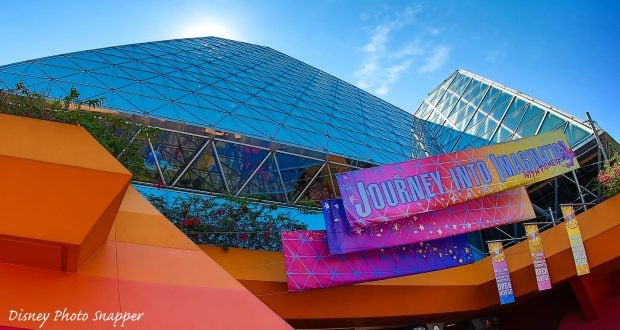
When EPCOT first opened in 1981, it was hardly a child-friendly Park. Between the presentational and pedagogical attractions of Future World, the lack of rides in World Showcase, and the massive amount of walking required to traverse the two halves of the Park, many of the smallest Guests had nothing to get excited about when visiting Walt Disney World’s second gate.
That is, until a little, purple-and-pink dragon by the name of Figment came onto the scene as a part of the Journey Into Imagination attraction. A star was born, one who would become a favorite of Walt Disney World fans, an unofficial mascot for the entirety of EPCOT, and even the protagonist of his own comic book series (and, potentially of a )!
So just how did this one accommodation to make EPCOT whimsically child-friendly end up becoming such an icon of the Disney Parks, and indeed for Walt Disney Imagineering itself? Jump into your steampunk dirigible because it’s time to explore the history of Figment!
RELATED: EPCOT’s Figment… The Movie? We Aren’t Making This Up
1982-1999 – Figment origins
Ostensibly, the Imagination pavilion in Future World was meant to appeal to kids. The pavilion had three parts: a 3D movie, a technological playground, and a ride-through attraction. However, on opening day, only the movie was ready. The playground – called Image Works – would open within six months, but the ride was much longer in development.
Imagineer Tony Baxter (who at the time was not yet “Imagineering legend Tony Baxter”) led the project, which would explore the human imagination in a playful way. According to writer Tim O’Brien in his biography of Baxter, Tony Baxter: First of the Second Generation of Walt Disney Imagineers, “The Journey Into Imagination team quickly came up with what Tony calls a ‘Santa Claus / Knowledge’ character known as Dreamfinder. The character needed a smaller, impish sidekick. Steve Kirk, one of the show’s lead designers had created a sculpture of Dreamfinder, a ‘steam punk’ style character who held a little dragon in his arms.”
Inspired by a throwaway joke from an episode of Magnum P.I., Baxter named the dragon “Figment,” as in “a figment of the imagination.” After being created by Dreamfinder in the first show scene, Figment would accompany the Guests as they rode through the different areas of the human imagination, exploring the visual arts, literature, nightmarish creatures, the performing arts, and science/technology. The ride would culminate in a scene featuring various films of Figment lifting weights, skiing, planting a flag on the moon, and taking part in other “imaginative” activities.
RELATED: Could Disney Be Getting Ready to Replace This Iconic EPCOT Attraction?
Both Dreamfinder and Figment were a hit amongst Guests (especially children), in no small part because they were the most “Disney-like” of characters created specifically for EPCOT (where, originally, no Disney characters were allowed to appear). Disney sold oodles of merchandise featuring Figment – shirts, hats, plush toys, figurines recreating scenes from the ride, and even a magnet set! – and had the Dreamfinder, with a puppet of Figment, make the rounds as a walk-around character. What’s more, Figment even appeared in a series of educational videos sold directly to schools! Nothing, it seemed, could stop his popularity.
Except for money.
1999 – 2002 – Figment in absentia
By the turn of the century, the Imagination pavilions sponsor, Kodak, was feeling the impact of digital photography on their bottom line. They could no longer afford to pay for the upkeep of the extravagant Journey Into Imagination ride, and so Disney decided to update the ride into a simpler, less expensive version called Journey Into YOUR Imagination.
Now, Guests were taken on a tour of the “Imagination Institute,” where Dr. Nigel Channing (played by Monty Python alum Eric Idle) sent them through a series of labs designed to stimulate their imagination. Save for a cameo in the ride queue, and a few subtle nods to him within the ride itself, Figment was nary to be seen.
Fans of the loveable fellow were quite vocal about how much they hated this version of the Imagination pavilion. One of those fans – Tony Baxter, himself, who had not been one of the developers of the redesign – noted, “The renewal of that ride absolutely missed what it was that Figment and Dreamfinder meant to young people. What it needed was a way to reflect those ideas to a more sophisticated audience viewing it as part of the digital world.”
It was thus not a surprise to fans when, after the Millennium celebration at EPCOT was completed, Disney announced that the ride would undergo yet another redesign, this time bringing Figment back into the story.
RELATED: The Parts of Walt Disney World We Often Forget To Visit
2002 – 2013 – Figment returns
The 2002 redesign, re-titled Journey Into Imagination with Figment, kept the same concept as the 1999 version, but added in Figment as a sort of sidekick/pest to Eric Idle’s Dr. Channing. Though universally noted as being not as good as the original ride, at least this version put Figment front and center, even featuring a visit to his upside-down house!
While still missing the whimsy and intricacy of the original ride, fans were at least satiated by this version, and Disney would come to use Figment more and more in its merchandising of EPCOT, including turning him into the mascot of the annual Food & Garden Festival and, increasingly, a semi-mascot of EPCOT itself. The popularity of the character would not yet lead to a new version of the ride, but it would bear dividends in another medium.
RELATED: How Does the Infamous Figment Popcorn Bucket Relate to the Tower of Terror?
2014 – 2022 & beyond – Figment triumphant?
After purchasing Marvel Comics in 2009, Disney began to take advantage of owning a comic book publisher by creating the “Disney Kingdom” line of mini-series based on individual Disney Parks attractions. Given the massive love for Figment from Park fans – and the fact that he might be the most fully-realized character from any attraction – it was no surprise that one of these comics was Figment. The writer of the series, Jim Zub, was given access to original design materials and concept art created by Tony Baxter and other Imagineer developers, and he used that material to flesh out a steampunk-styled origin of the Dreamfinder and Figment.
The story begins in London in 1910, with the Dreamfinder creating a machine to literally journey into his imagination, which is where he meets Figment. After a series of misadventures, the pair end up in the present day, flying towards Spaceship Earth with Figment exclaiming, “I can already tell we’re somewhere exciting and new…somewhere full of possibilities. I bet we can use imagination to discover all kinds of new things!” The 2015 sequel – called, of course, Figment 2 – then takes place in the present, at a reimagined (pun intended) Imagination Institute that looks just like the Imagination pavilion itself.
RELATED: Orlando Airport Gives Shout Out to EPCOT’s Figment with Rainbow Tunnel
Between these comics, the steady popularity of Figment merchandise, and the recent announcement that Seth Rogen would be producing a Figment movie, the royal-purple-pigmented little dragon has reached new heights of public awareness. For now, though, the many Figment fans can only wait and hope that this will ultimately lead to a new Journey Into Imagination that harkens back to Tony Baxter’s original creation.
Until then, we’ll all just have to use our imaginations.

 DisneyTips.com Your Guide To A Great Disney Vacation
DisneyTips.com Your Guide To A Great Disney Vacation








